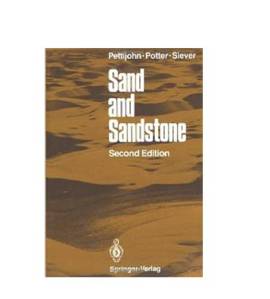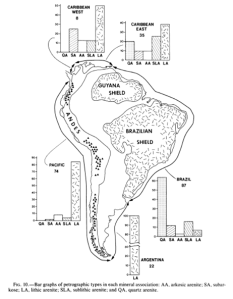I only ever truly loved two textbooks. I only ever loved these books because they were capable of captivating my attention, enhancing my understanding, and making me realize the depth of the subject. Most textbooks are poorly written encyclopedias that should be thrown out, no matter how beautiful they look and how famous their writers. No matter how relatively useful they are.
The first textbook I ever truly loved was ‘Sand and Sandstone’ by Francis Pettijohn, Paul Potter and Raymond Siever. It was first published in 1972 by Springer. I used a library copy during my MSc studies, wanted to own it right away, but couldn’t afford it until I was a professional with a real salary. I bought it in 1984. The second edition was published in 1987 and you can still buy it for $239.00 (ex shipping). YES! I am obviously not the only one: this must be a darn good book if Springer can still sell it for that price 26 years after it was published!
What was it about this book? Opening it again after many years, I can’t really find a specific page to bring me back to that feeling of excitement. Maybe it was its inviting language: on page 7 the young student reads: ‘just where is sand in the world today…?’ Or maybe it was because the book was actually the result of a workshop and therefore reads as a workshop discussion, something I wasn’t really exposed to as a student in the Netherlands. For example, on p. 107 we read “Truly massive beds of sand appear to be very rare which is indeed fortunate, for if they were common, we would be hard pressed to explain them”, showing that the writers aren’t all-knowing wizards, they are real human beings with questions.
But they were confident researchers! The paragraph on Sandstone Petrogenesis has the following subsections: The Question, The Hypotheses, The Evidence, The Verdict. The Question is whether Climate, Tectonics, Provenance or Depositional Environment is the most important influence on the petrographic character of a sandstone. The Verdict: Tectonics – a textbook with sections written as a whodunnit, terrific.
Maybe I was simply excited about this book because I was from the Netherlands, a country with next to no rock outcrops, consisting largely of sand, mud and peat and locally a lot of glacial erratics (certainly in my home town, because I grew up on a moraine) – and here was something that made all that home grown dirt a Science!
Of the three authors of Sand and Sandstone, I only ever met Paul Potter once when he gave a talk about his research on the tectonic signature of the beach sands of South America. He published a lot on that topic – extremely elegant papers mostly in the rather obscure ‘Journal of Geology’.
Those articles on the modern sands of South America are true gems. I have routinely used the three referenced below here when teaching sedimentology. Paul Potter asked a simple question: “how can we reconstruct ancient continents on the basis of sandstone petrology”? Obviously: by studying a modern continent, one that is properly situated and nicely varied (geologically speaking). Collect a few hundred samples (he calls it his ’18 year hobby project), process and analyze them in the same consistent manner – and plot the results:
There is a wonderful interview with Paul Potter on http://www.minutegeology.com – I have no idea who put that site together, but it’s worth checking out – nothing but interviews with highly respected earth scientists. Paul is very modest about his own accomplishments, giving mostly credit to his colleagues and characterizing himself as “someone who happens to be fairly good at finding a rose in a field of weeds”, a statement that implicitly refers to Kuhn’s “Structure of Scientific Revolutions”. Kuhn defined most scientific practice as ‘ordinary mopping up’. Paul Potter says that “ordinary science is nuts and bolts”, that “someone sometimes has an idea” (that sticks out) and defines the concept of Sequence Stratigraphy as such an idea. I think that “being able to find a rose in a field of weeds” is also proof of being in the business of generating ideas. Deciphering the tectonics of a whole continent on the basis of a few hundred beach samples is definitely an original idea.
References
Pettijohn, F. J., P.E. Potter and R. Siever, 1987, Sand and Sandstone. Springer Verlag, 618 p.
Potter, P.E., 1983, South America and a few grains of Sand. Part I: Beach Sands. The Journal of Geology, v. 94, no. 3, p. 301-319
Potter, P.E., 1984, South African (error! should have read ‘American’) modern beach sand and plate tectonics. Nature, v. 311, p. 645-649




Oh my. I will see if this works. I too am a Potter fan and I distinctly remember reading a chapter that I thought was called Rivers. Potter talks about old and new rivers, the average age of a river (ie low long they persist….). I need to track it down for a review paper. Is it in Pettijohn? Title names don’t look like what I remember.
Oops, I’m sorry – I should have answered this question a long time ago. I do not remember Potter writing about old and new rivers! I don’t own Pettijohn anymore.
Paul wrote two papers with the title “Big Rivers”
Potter, P.E., 1978. Significance and origin of big rivers. The Journal of Geology, 86(1), pp.13-33.
Potter, P.E., 1978. Petrology and chemistry of modern big river sands. The Journal of Geology, 86(4), pp.423-449.
thank you!
I first met Paul Potter in the late summer of 1965. He came to the laboratory where I was working as a petrographer / forensic engineering geologist. He came to see my supervisor, Bob Barnett, an old friend and to talk to me regarding data plots I had been making from petrographic analyses of Ohio River sands dredged from various river-mile locations from Pittsburgh to Cairo, IL. I plotted this data by river-mile so I could see how the local geology altered the composition of sands along the entire stretch of the Ohio River. Bob “Barney” Barnett introduced me to Paul and we instantly became good friends. He asked to look at my plots and asked for copies and we talked for quite a while. For the rest of my career he would come by for visits every few months. He was working at Indiana University at that time but by 1970 he came to work at the Geology Department of the University of Cincinnati. We kept in constant contact and when I won a Fellowship in 1986 I returned to the University of Cincinnati and took one of his courses that he chose to teach at Miami University in Oxford, Ohio from 6pm to 9pm every Thursday evening. That was about a 1 1/2 – hour drive from my home so my wife, Donna always came along and Paul instantly became friends with Donna. From that time on, the three of us would often get together for dinner and often drove up-river to Augusta, KY for dinner at one of Paul’s favorite eating places. We did this for many years, but the last time we got together was the Sky Galley at Lunken Airport in Cincinnati. His osteoporosis problem was getting worse and then I had a seizure a month later and was also diagnosed with osteoporosis when both shoulders broke during the seizure. We did not see each other again until the Geological Society of America meeting in Indianapolis in 2018 and Paul was wheel-chair bound by that time but we talked for a while. We did not meet again after that but we remained life-long friends until his death on 7/4/2020. He would have turned 95 on August 30th, 2020. Paul was the most honorable and decent gentleman I have ever met in my life and that is how I will always remember him in the time I have left on this earth
Thank you so much for this story, I’m very glad it will live on my blog, which I promise I’ll never shut down. Several years before my one-time meeting with Paul Potter, I met Elena Franzinelli, the Manaus-based sedimentologist with whom Paul Potter cooperated on some of these South American sedimentology projects. I’m still in awe of the elegance of their thinking and methods. All the best!